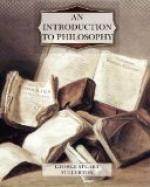Thus, the touch object, the tree as he feels it under his hand, may come to be regarded as the sign of the presence of those entities that science seems, at present, to regard as ultimate. Does this prevent it from being the object which has stood as the interpreter of all those diverse visual sensations that we have called different views of the tree? They are still the appearances, and it, relatively to them, is the reality. Now we find that it, in its turn, can be used as a sign of something else, can be regarded as an appearance of a reality more ultimate. It is clear, then, that the same thing may be regarded both as appearance and as reality—appearance as contrasted with one thing, and reality as contrasted with another.
But suppose one says: I do not want to know what the real external world is to this man or to that man; I want to know what the real external world is. What shall we say to such a demand?
There is a sense in which such a demand is not purely meaningless, though it may not be a very sensible demand to make. We have seen that an increase of knowledge about things compels a man to pass from the real things of common life to the real things of science, and to look upon the former as appearance. Now, a man may arbitrarily decide that he will use the word “reality” to indicate only that which can never in its turn be regarded as appearance, a reality which must remain an ultimate reality; and he may insist upon our telling him about that. How a man not a soothsayer can tell when he has come to ultimate reality, it is not easy to see.
Suppose, however, that we could give any one such information. We should then be telling him about things as they are, it is true, but his knowledge of things would not be different in kind from what it was before. The only difference between such a knowledge of things and a knowledge of things not known to be ultimate would be that, in the former case, it would be recognized that no further extension of knowledge was possible. The distinction between appearance and reality would remain just what it was in the experience of the plain man.
22. THE BUGBEAR OF THE “UNKNOWABLE.”—It is very important to recognize that we must not go on talking about appearance and reality, as if our words really meant something, when we have quite turned our backs upon our experience of appearances and the realities which they represent.
That appearances and realities are connected we know very well, for we perceive them to be connected. What we see, we can touch. And we not only know that appearances and realities are connected, but we know with much detail what appearances are to be taken as signs of what realities. The visual experience which I call the house as seen from a distance I never think of taking for a representative of the hat which I hold in my hand. This visual experience I refer to its own appropriate touch thing, and not to another. If what looks like a beefsteak could really be a fork or a mountain or a kitten indifferently,—but I must not even finish the sentence, for the words “look like” and “could really be” lose all significance when we loosen the bond between appearances and the realities to which they are properly referred.




